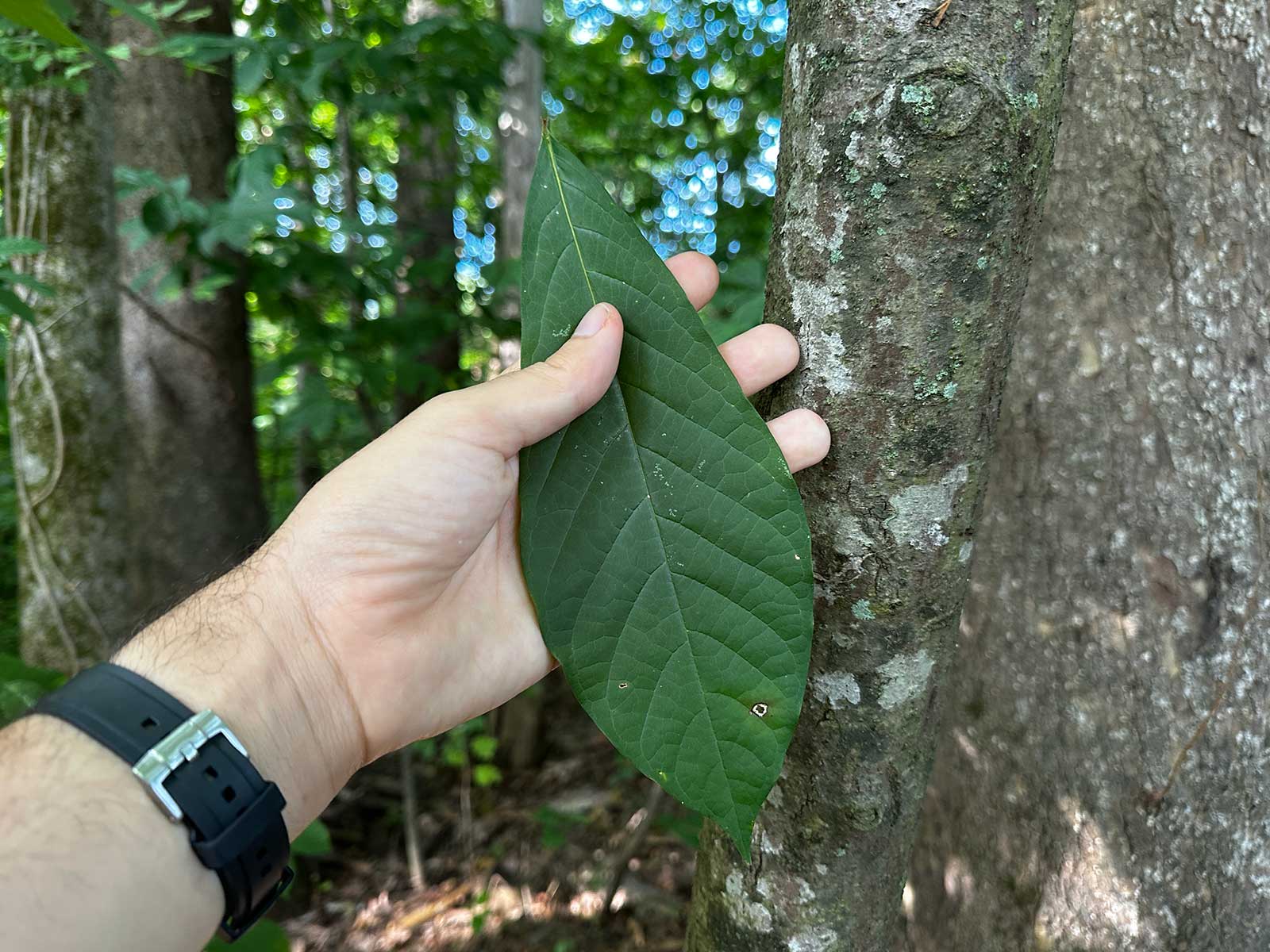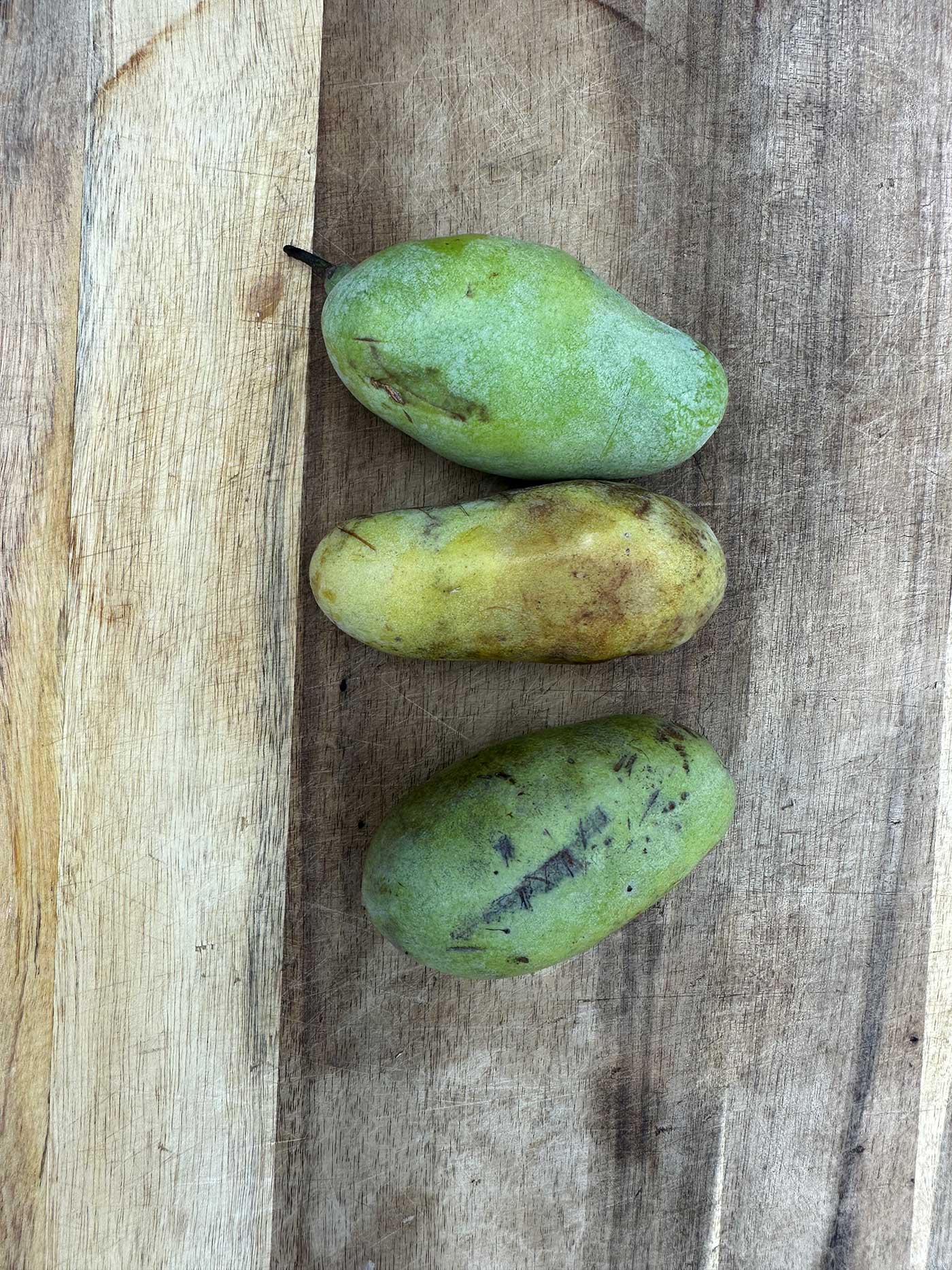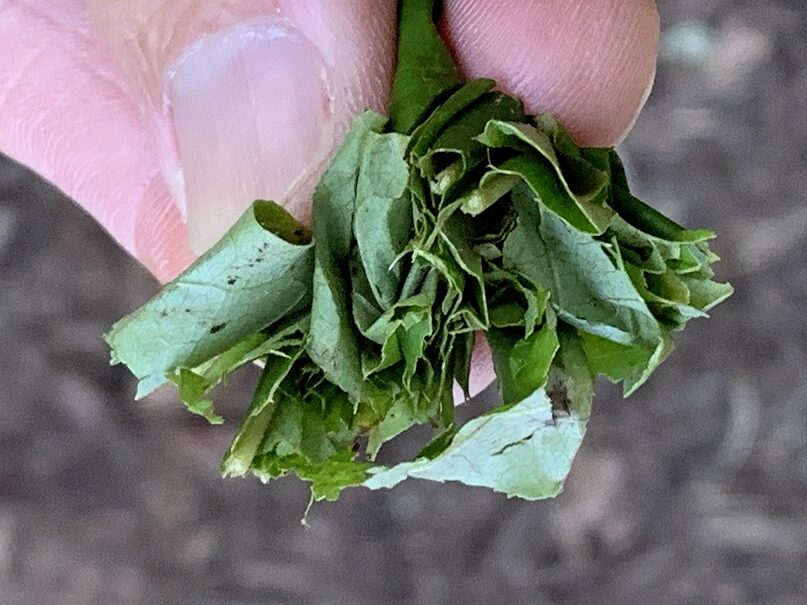Pawpaw Fruit: Here’s How (and Why) to Forage for Pawpaw This Fall
Right now, there’s a native, tropical-tasting fruit ripening in forests throughout the United States. The Asimina triloba, commonly known as pawpaw, is found from New York to Florida and as far west as Texas. If you fall within its native range, it’s worth the hike to find this rare delicacy that tastes like a combination of mango, pineapple, and banana.
Here’s everything you need to know to find ripe pawpaw fruit.
Identification

Photo by Scott Einsmann
Pawpaw trees have long, oval-shaped leaves and can vary from short shrubs to 25-feet tall. The bark is light gray with a smooth texture that I’d compare to a beech tree. The fruit’s skin is green to yellow. Pawpaw fruit is oblong and varies in size, but most are around 4 inches. The interior of the fruit is soft, pale yellow, very fragrant, and will have several seeds.
Where to Find Pawpaws

USGS
I usually find pawpaw trees in creek and river bottoms, where they grow in the understory of taller hardwood trees. They thrive in areas with ready access to water but won’t tolerate prolonged flooding. Also, don’t overlook the hillsides surrounding river bottoms.
Believe it or not, you can often sniff out pawpaw trees during this time of year. On a recent foraging trip, I found a stand of pawpaw trees by the sudden smell of overripe and fermented fruit. A quick scan revealed rotting pawpaw fruit on the ground and loads of ripening fruit in the trees.
How to Pick Pawpaw Fruit
Pawpaws ripen from August to October, depending on your location. It’s really important to eat ripe fruit because they’re a lot like astringent persimmons — you won’t like the flavor of one that’s not ripe. But you can pick underripe pawpaws and let them ripen on your kitchen counter. This should only take a few days.
It’s rare to find a perfectly ripe fruit hanging on a limb. So if you’re looking for pawpaw fruit to eat right away, look on the forest floor for recently-fallen fruit. Ripe pawpaws will feel like a ripe avocado. They’ll have a little give but won’t be completely mushy. Overripe ones turn black.
How to Eat Pawpaw Fruit
I typically eat pawpaws as a trail snack right after finding them. You can crack a ripe fruit in half, squeeze the custardy interior into your mouth, and spit out the seeds as you eat. Pawpaws have a limited shelf life, so it’s best to eat them quickly or turn them into bread, jam, and ice cream.
Plant a Pawpaw Tree
It’s fun to forage fruit, but the selective breeding done to pawpaws has drastically improved their size and flavor. If you love the way pawpaws taste, you can plant two named varieties in your backyard, and you’ll have fruit in a few years. Here are some of the top varieties to add to your yard.
- Shenandoah
- Rappahannock
- Potomac
- Allegheny
While they’re an understory tree in the wild, you can grow them in a full-sun location, which will increase their production. Just know that they don’t like to dry out or be in standing water, especially when young. Keep in mind that you’ll need two different varieties to cross-pollinate each other. —Scott Einsmann
More Pawpaw Facts

Pawpaw Fruits Are Loaded with Vitamins
The size of pawpaw fruits can vary. Tiny ones weigh only a few ounces, but whoppers can weigh more than a pound apiece. With its large inedible seeds removed, the average pawpaw fruit will give you more than a 100-gram serving. This small amount (3.5 ounces) is anything but modest in its nutritional offerings. It supplies small amounts of fiber, protein, and fat and also provides more than 30 percent of the daily allowance of vitamin C. It also contains vitamins A and B. You’ll even get several essential minerals with each bite. That 100-gram serving provides 10 percent of your daily potassium, 39 percent of your iron, 25 percent copper, 11 percent magnesium, and a very generous 130 mg of the daily value of manganese.
Deer Love Pawpaw Fruit
The Pawpaw tree’s home range overlaps the heart of whitetail country. Deer like to forage on pawpaw fruit, but they won’t eat the branches or leaves because they contain a neurotoxin called annonacin. According to Whitetail Hill, “Deer will seek out large producing paw paws and visit them regularly while fruit is dropping in early-mid fall. Paw paws only take about 4 to 8 years to start producing, so they are a very early producing tree.”
Pawpaw Leaves Can Act as Insect Repellent

Photo by Tim MacWelch
If the insect repellent bottle is empty and you’re tired of being bitten by bugs, pawpaw can help. The large ovate pawpaw leaves can be crushed and rubbed onto bare skin and clothing as a passable repellent, mainly for flying insects. For best results, tear up the young spring leaves. These are the strongest and most pungent, and they smell of tar or asphalt. You can also use crushed pawpaw leaves in debris beds and other survival shelter bedding to offer a little more protection from insects while you sleep. These leaves aren’t anywhere near as effective as DEET or even commercially available natural insect repellent, but any help battling bugs is better than none.
Pawpaw Wood Is Ideal for Carvers
Many woodcarvers enjoy basswood for carving figures and other artistic pieces, so much so that craft stores sell basswood blocks (at a premium price). Basswood is great stuff, don’t get me wrong. Pawpaw, however, is just as good, and it’s free. I actually like the unusual greenish-yellow color of the wood. While it’s not particularly rot-resistant, it should last a long time if kept in a dry location. Light and buoyant, you could use this wood for duck decoy carving. You could also carve and paint your own fishing bobbers. If your carving skills are superior to mine, you could even carve figurines and other keepsakes for your friends and loved ones.
Pawpaw Leaves Are a Multi-Use Resource
For a creative survivalist, the large leaves of a pawpaw tree can offer a wealth of uses. They can be employed as a makeshift thatching material for shelters and other structures. I’ve used them to line baskets so they stay clean. This trick lets you use your vine or grass baskets like plates for serving food, and you can toss the dirty leaf liner when you’re done eating. Pawpaw leaves can be used to wrap food for cooking (though they are just wrappers and not edible themselves). These versatile leaves can even serve the ignoble use of toilet paper when your roll runs out. Just stack them several layers thick for the best result. —Tim MacWelch
Read Next: 15 Wild Edibles You Can Forage for in the Fall
The Upshot
Whether you want to head out on a pawpaw fruit finding mission or you happen to find them while you’re hanging a deer stand, you can use the above information as a guide to identifying and enjoying this native delicacy. Just make sure you’re correctly identifying pawpaw fruit, and enjoy.
The post Pawpaw Fruit: Here’s How (and Why) to Forage for Pawpaw This Fall appeared first on Outdoor Life.




